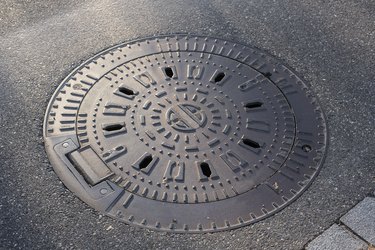
Like most people, you probably rarely give a thought to how your city's sewer system works or how it's maintained. It's one of those out of sight, out of mind things, and besides, is there really anyone who wants to know much about sewers? The answer, actually, is yes. All municipalities employ people who are very concerned about all those pipes running through the ground below, and smoke tests are one of the most important steps they take to determine the integrity of your town's system.
What Is a Smoke Test?
Video of the Day
The job of a sanitary sewer is to handle sewage only. If water from a heavy rain is able to infiltrate or pour into a compromised sanitary sewer, an exceeded capacity can overwhelm the system, resulting in wastewater backup into homes and businesses and overflow through manholes into streets and surrounding areas.
Video of the Day
Sewer utilities all around the country check the integrity of city sewer system main lines and property-connecting lateral lines using smoke testing to find leaks. The objective is to identify locations where groundwater is infiltrating cracked pipes and where stormwater is pouring in through broken manholes and illegally connected yard drains, roof drains, and sump pumps.
What Happens During a Test?
During a smoke test, nontoxic smoke is blown through one of your neighborhood manholes into the sewer line. Pressure forces it into the main line and connecting pipes and through any leaks that are present. Leaks are revealed by the appearance of smoke rising from the ground, from manholes, and from gutters and vents on buildings and houses.
What’s Your Role?
Representatives from your community will notify you several weeks in advance of the smoke test. Be sure to read anything you receive so you can prepare. In addition to checking in regularly with local government websites and social media pages for information, try to attend any scheduled public or virtual meetings about the test so you can ask questions.
A smoke test for a city block usually takes about 30 minutes. Crew members performing the test won't need to enter your home, and it isn't necessary for you to be at home while the test is conducted.
On the day of the test, pour a gallon of water into floor drains and run water for about a minute to close off P-traps in unused drains, sinks, and tubs to keep smoke from getting into your house. You're unlikely to see smoke inside your home, but don't be concerned if you do. It's nontoxic and won't hurt plants or pets. Just open doors and windows for ventilation and remember to call a plumber to rule out a sewer-connection problem. Also, since members of your local fire department will be involved in the testing, you should call so they can confirm that smoke in your home is from the test and not from an unrelated fire.
If a problem is found on your property, you'll receive a letter from your city detailing the issue found in your line and noting a deadline for getting it fixed.